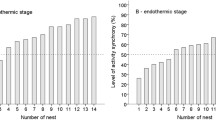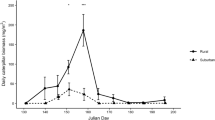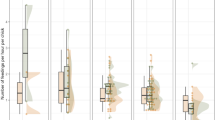Abstract
Several hypotheses propose that parent birds might synchronize their visits to the nest, but field studies have historically overlooked the temporal pattern of parental care. Either synchrony or asynchrony could provide adaptive benefits; alternatively, any observed synchrony could simply be a byproduct of other coordinated behavior among caregivers. Few studies have quantified visit synchrony in cooperatively breeding birds with multiple caregivers. We tested whether visits to the nest are more or less synchronized than expected by chance in the communally nesting greater ani (Crotophaga major), a tropical bird that breeds in groups of four to eight adult caregivers. Across 27 breeding groups, anis did not consistently synchronize nest visits more than expected by chance; however, six groups (22%) did exhibit significant synchrony (up to 44% of visits). Nest visit synchrony was not associated with fledging success or brood size, as would be predicted by two common adaptive hypotheses, and instead might be a byproduct of synchronized foraging.
Significance statement
Various hypotheses may explain why birds either synchronize or evenly space their visits to the nest. Such coordination could increase fitness; however, its prevalence and consequences remain poorly understood, particularly in cooperative breeders. We tested whether nest visits were more or less synchronized than expected by chance in a communally nesting bird, the greater ani, which forms breeding groups of four to eight adults. While some breeding groups synchronized nest visits more than expected, most did not. Further, groups with more synchronized visits did not have increased fledging success, suggesting that the synchrony we observed might not provide a fitness benefit but rather could be a byproduct of adult social behavior away from the nest.



Similar content being viewed by others
Data availability
All data generated or analyzed during this study are included in this published article and its supplementary information files.
References
Alonso-Alvarez C, Velando A (2012) Benefits and costs of parental care. In: Royle NJ, Smiseth PT, Kölliker M (eds) The evolution of parental care. Oxford University Press, Oxford, pp 40–61
Araya-Salas M, Wojczulanis-Jakubas K, Phillips EM, Mennill DJ, Wright TF (2017) To overlap or not to overlap: context-dependent coordinated singing in lekking long-billed hermits. Anim Behav 124:57–64. https://doi.org/10.1016/j.anbehav.2016.12.003
Beauchamp G (1998) The effect of group size on mean food intake rate in birds. Biol Rev 73:449–472. https://doi.org/10.1017/S0006323198005246
Bebbington K, Hatchwell BJ (2016) Coordinated parental provisioning is related to feeding rate and reproductive success in a songbird. Behav Ecol 27:652–659. https://doi.org/10.1093/beheco/arv198
Beintema AJ, Visser GH (1989) The effect of weather on time budgets and development of chicks of meadow birds. Ardea 77:181–192
Clutton-Brock TH (1991) The evolution of parental care. Princeton University Press, Princeton
Cockburn A (2006) Prevalence of different modes of parental care in birds. Proc R Soc Lond B 273:1375–1383. https://doi.org/10.1098/rspb.2005.3458
Doutrelant C, Covas R (2007) Helping has signalling characteristics in a cooperatively breeding bird. Anim Behav 74:739–747. https://doi.org/10.1016/j.anbehav.2006.11.033
Enns J, Williams TD (2021) Paying attention but not coordinating: parental care in European starlings (Sturnus vulgaris). Anim Behav 193:113–124. https://doi.org/10.1016/j.anbehav.2022.09.009
Foster WA, Treherne JE (1981) Evidence for the dilution effect in the selfish herd from fish predation on a marine insect. Nature 293:466–467. https://doi.org/10.1038/293466a0
Griffith SC (2019) Cooperation and coordination in socially monogamous birds: moving away from a focus on sexual conflict. Front Ecol Evol 7:455. https://doi.org/10.3389/fevo.2019.00455
Grissot A, Araya-Salas M, Jakubas D, Kidawa D, Boehnke R, Błachowiak-Samołyk K, Wojczulanis-Jakubas K (2019) Parental coordination of chick provisioning in a planktivorous Arctic seabird under divergent conditions on foraging grounds. Front Ecol Evol 7:349. https://doi.org/10.3389/fevo.2019.00349
Haff TM, Magrath RD (2011) Calling at a cost: elevated nestling calling attracts predators to active nests. Biol Lett 7:493–495. https://doi.org/10.1098/rsbl.2010.1125
Halliwell C, Beckerman AP, Germain M, Patrick SC, Leedale AE, Hatchwell BJ (2022) Coordination of care by breeders and helpers in the cooperatively breeding long-tailed tit. Behav Ecol 33:844–858. https://doi.org/10.1093/beheco/arac048
Haskell D (1994) Experimental evidence that nestling begging behaviour incurs a cost due to nest predation. Proc R Soc Lond B 257:161–164. https://doi.org/10.1098/rspb.1994.0110
Ihle M, Pick JL, Winney IS, Nakagawa S, Burke T (2019a) Measuring up to reality: null models and analysis simulations to study parental coordination over provisioning offspring. Front Ecol Evol 7:142. https://doi.org/10.3389/fevo.2019.00142
Ihle M, Pick JL, Winney IS, Nakagawa S, Schroeder J, Burke T (2019b) Rearing success does not improve with apparent pair coordination in offspring provisioning. Front Ecol Evol 7:405. https://doi.org/10.3389/fevo.2019.00405
Johnstone RA, Manica A, Fayet AL, Stoddard MC, Rodriguez-Gironés MA, Hinde CA (2014) Reciprocity and conditional cooperation between great tit parents. Behav Ecol 25:216–222. https://doi.org/10.1093/beheco/art109
Karasov WH, Wright J (2002) Nestling digestive physiology and begging. In: Wright J, Leonard ML (eds) The evolution of begging. Kluwer Academic Publishers, Dordrecht, pp 199–219
Kern JM, Radford AN (2018) Experimental evidence for delayed contingent cooperation among wild dwarf mongooses. P Natl Acad Sci USA 115:6255–6260. https://doi.org/10.1073/pnas.1801000115
Khwaja N, Massaro M, Martin TE, Briskie JV (2019) Do parents synchronise nest visits as an antipredator adaptation in birds of New Zealand and Tasmania? Front Ecol Evol 7:389. https://doi.org/10.3389/fevo.2019.00389
Koenig WD, Walters EL (2016) Provisioning patterns in the cooperatively breeding acorn woodpecker: does feeding behaviour serve as a signal? Anim Behav 119:125–134. https://doi.org/10.1016/j.anbehav.2016.06.002
Leniowski K, Wȩgrzyn E (2018) Synchronisation of parental behaviours reduces the risk of nest predation in a socially monogamous passerine bird. Sci Rep 8:7385. https://doi.org/10.1038/s41598-018-25746-5
Mainwaring MC, Griffith SC (2013) Looking after your partner: sentinel behaviour in a socially monogamous bird. PeerJ 1:e83. https://doi.org/10.7717/peerj.83
Mariette MM, Griffith SC (2012) Nest visit synchrony is high and correlates with reproductive success in the wild zebra finch Taeniopygia guttata. J Avian Biol 43:131–140. https://doi.org/10.1111/j.1600-048X.2012.05555.x
Martin TE, Tobalske B, Riordan MM, Case SB, Dial KP (2018) Age and performance at fledging are a cause and consequence of juvenile mortality between life stages. Sci Adv 4:eaar1988. https://doi.org/10.1126/sciadv.aar1988
Matysioková B, Remeš V (2018) Evolution of parental activity at the nest is shaped by the risk of nest predation and ambient temperature across bird species. Evolution 72:2214–2224. https://doi.org/10.1111/evo.13580
McDonald PG, te Marvelde L, Kazem AJN, Wright J (2008) Helping as a signal and the effect of a potential audience during provisioning visits in a cooperative bird. Anim Behav 75:1319–1330. https://doi.org/10.1016/j.anbehav.2007.09.005
Muchai M, du Plessis MA (2005) Nest predation of grassland bird species increases with parental activity at the nest. J Avian Biol 36:110–116. https://doi.org/10.1111/j.0908-8857.2005.03312.x
Nomano FY, Browning LE, Savage JL, Rollins LA, Griffith SC, Russell AF (2015) Unrelated helpers neither signal contributions nor suffer retribution in chestnut-crowed babblers. Behav Ecol 26:986–995. https://doi.org/10.1093/beheco/arv023
Nomano FY, Savage JL, Browning LE, Griffith SC, Russell AF (2019) Breeding phenology and meteorological conditions affect carer provisioning rates and group-level coordination in cooperative chestnut-crowned babblers. Front Ecol Evol 7:423. https://doi.org/10.3389/fevo.2019.00423
Pick JL, Khwaja N, Spence MA, Ihle M, Nakagawa S (2023) Counter culture: causes, extent and solutions of systematic bias in the analysis of behavioural counts. PeerJ 11:e15059. https://doi.org/10.7717/peerj.15059
R Core Team (2021) R: a language and environment for statistical computing. R Foundation for Statistical Computing, Vienna, Austria. https://www.r-project.org/
Raihani NJ, Nelson-Flower MJ, Moyes K, Browning LE, Ridley AR (2010) Synchronous provisioning increases brood survival in cooperatively breeding pied babblers. J Anim Ecol 79:44–52. https://doi.org/10.1111/j.1365-2656.2009.01606.x
Riehl C (2011) Living with strangers: direct benefits favour non-kin cooperation in a communally nesting bird. Proc R Soc Lond B 278:1728–1735. https://doi.org/10.1098/rspb.2010.1752
Riehl C (2012) Mating system and reproductive skew in a communally breeding cuckoo: hard-working males do not sire more young. Anim Behav 84:707–714. https://doi.org/10.1016/j.anbehav.2012.06.028
Riehl C, Jara L (2009) Natural history and reproductive biology of the communally breeding greater ani (Crotophaga major) at Gatún Lake, Panama. Wilson J Ornithol 121:679–687. https://doi.org/10.1676/09-017.1
Riehl C, Smart ZF (2022) Climate fluctuations influence variation in group size in a cooperative bird. Curr Biol 32:4264–4269. https://doi.org/10.1016/j.cub.2022.07.057
Riehl C, Strong MJ (2015) Social living without kin discrimination: experimental evidence from a communally breeding bird. Behav Ecol Sociobiol 69:1293–1299. https://doi.org/10.1007/s00265-015-1942-9
Riehl C, Strong MJ (2018) Stable social relationships between unrelated females increase individual fitness in a cooperative bird. Proc R Soc B 285:20180130. https://doi.org/10.1098/rspb.2018.0130
Riehl C, Strong MJ (2019) Social parasitism as an alternative reproductive tactic in a cooperatively breeding cuckoo. Nature 567:96–99. https://doi.org/10.1038/s41586-019-0981-1
Rosa SM, Murphy MT (1994) Trade-offs and constraints on eastern kingbird parental care. Wilson Bull 106:668–678
Royle NJ, Smiseth PT, Kölliker M (eds) (2012) The evolution of parental care. Oxford University Press, Oxford
Sargent S (1993) Nesting biology of the yellow-throated euphonia: large clutch size in a Neotropical frugivore. Wilson Bull 105:285–300
Savage JL, Hinde CA, Johnstone RA (2020) Editorial: cooperation and coordination in the family. Front Ecol Evol 8:614863. https://doi.org/10.3389/fevo.2020.614863
Savagian AG, Riehl C (2022) Begging is an honest signal of hunger in a communally nesting bird with low genetic relatedness. Behav Ecol Sociobiol 76:146. https://doi.org/10.1007/s00265-022-03252-z
Savagian AG, Riehl C (2023) Effects of brood and group size on nestling provisioning and resource allocation in a communal bird. Behav Ecol. https://doi.org/10.1093/beheco/arad020. (published online)
Schlicht E, Santema P, Schlicht R, Kempenaers B (2016) Evidence for conditional cooperation in biparental care systems? A comment on Johnstone et al. Behav Ecol 27:e2–e5. https://doi.org/10.1093/beheco/arw036
Shen S-F, Chen H-C, Vehrencamp SL, Yuan H-W (2010) Group provisioning limits sharing conflict among nestlings in joint-nesting Taiwan yuhinas. Biol Lett 6:318–321. https://doi.org/10.1098/rsbl.2009.0909
Skutch AF (1949) Do tropical birds rear as many young as they can nourish? Ibis 91:430–455. https://doi.org/10.1111/j.1474-919X.1949.tb02293.x
Sorato E, Gullett PR, Griffith SC, Russell AF (2012) Effects of predation risk on foraging behaviour and group size: adaptations in a social cooperative species. Anim Behav 84:823–834. https://doi.org/10.1016/j.anbehav.2012.07.003
Trapote E, Canestrari D, Baglione V (2021) Female helpers signal their contribution to chick provisioning in a cooperatively breeding bird. Anim Behav 172:113–120. https://doi.org/10.1016/j.anbehav.2020.12.011
van Rooij EP, Griffith SC (2013) Synchronised provisioning at the nest: parental coordination over care in a socially monogamous species. PeerJ 1:e232. https://doi.org/10.7717/peerj.232
Wojczulanis-Jakubas K, Araya-Salas M, Jakubas D (2018) Seabird parents provision their chick in a coordinated manner. PLoS ONE 13:e0189969. https://doi.org/10.1371/journal.pone.0189969
Acknowledgements
We thank Danielle Almstead, Luke Carabbia, Christa Morris, Zachariah Smart, Meghan Strong, and Oliver Whang for assistance in the field and Prabhanjana Acharya and Willow Dalehite for contributing to video coding. We thank the Smithsonian Tropical Research Institute, especially Melissa Cano, for logistical support in the field. Merlijn Staps and David Weber provided useful insights on data analysis, and Breanna Bennett, Trey Hendrix, Severine Hex, Joshua LaPergola, Joel Pick, and an anonymous reviewer provided feedback that greatly improved the manuscript.
Funding
This material is based upon work supported by the National Science Foundation (Graduate Research Fellowship Program Grants No. DGE-2039656 and DGE-1656466, IOS-1755279, IOS-184543). Additional funding was provided by the American Ornithological Society, the American Philosophical Society, and Princeton University (Department of Ecology and Evolutionary Biology, Program in Latin American Studies, and High Meadows Environmental Institute).
Author information
Authors and Affiliations
Corresponding author
Ethics declarations
Ethics approval
All methods were approved by the Institutional Animal Care and Use Committees of Princeton University (2114F-17-19) and the Smithsonian Tropical Research Institute (2015-0601-2018, 2018-0403-2021). All applicable international, national, and/or institutional guidelines for the use of animals were followed.
Competing interests
The authors declare no competing interests.
Disclaimer
Any opinions, findings, and conclusions or recommendations expressed in this material are those of the authors and do not necessarily reflect the views of the National Science Foundation.
Additional information
Communicated by M. Leonard
Publisher's note
Springer Nature remains neutral with regard to jurisdictional claims in published maps and institutional affiliations.
Supplementary Information
Below is the link to the electronic supplementary material.
Rights and permissions
Springer Nature or its licensor (e.g. a society or other partner) holds exclusive rights to this article under a publishing agreement with the author(s) or other rightsholder(s); author self-archiving of the accepted manuscript version of this article is solely governed by the terms of such publishing agreement and applicable law.
About this article
Cite this article
Smith, M.G., Savagian, A.G. & Riehl, C. Caregivers in a communally nesting bird do not consistently synchronize nest visits. Behav Ecol Sociobiol 77, 84 (2023). https://doi.org/10.1007/s00265-023-03361-3
Received:
Revised:
Accepted:
Published:
DOI: https://doi.org/10.1007/s00265-023-03361-3




